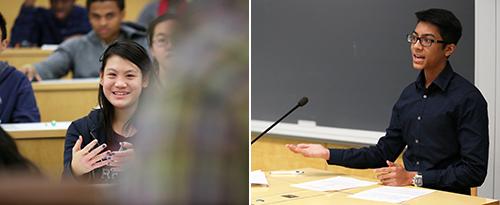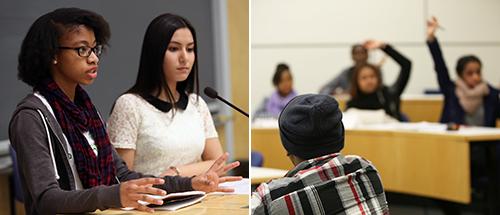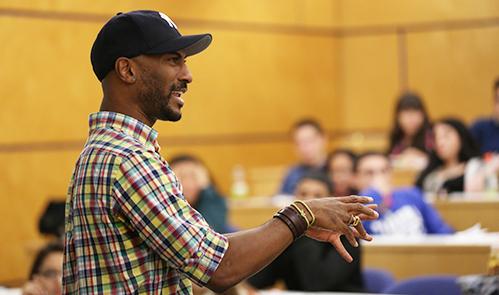All Rise
Teenagers from Across New York City Wake up Early on Saturdays to Attend Columbia Law School's High School Law Institute, Where They Take Constitutional and Criminal Law Classes Taught by Law Students
New York, March 3, 2015—The young women and men show up early on Saturday mornings at Columbia Law School, where they learn about due process, mens rea, double jeopardy, and identifying the elements of a statute.
But they aren’t law students. They are teenagers from public high schools in every borough of New York City, and some, like Maddison McKnight, are as young as 13.
A freshman at East Side Community High School in the East Village, McKnight doesn’t yet know what she wants to be when she grows up. And yet she happily gives up her Saturdays during the fall, leaving her home in Flushing, Queens in time to arrive at Columbia Law School’s High School Law Institute (HSLI) at 9 a.m.
| High school students present to peers and Columbia Law School students during a High School Law Institute session. |
The free program, run by law school students, gives these teens more than just breakfast, lunch, and exposure to legal concepts. They gain confidence, experience in public speaking, and a better sense of the rewards a strong work ethic can garner.
“Developing that speaking ability and analytical thinking is something they’re not necessarily going to get in their high school curriculum,” said Kelly Freund ’16, HSLI’s co-president along with Eric West ’16. “It’s great enrichment, regardless of whether they go on to law school.”
The High School Law Institute features classes in criminal and constitutional law, as well as a mock trial complete with evidence presentation and witness testimony. Students who return for a second year in the program participate in a more advanced daylong moot court competition, featuring appellate-style arguments. Law students reach out to public schools to recruit the high school students, devise the curriculum, and teach the classes. They also represent their alma maters on College Day, an annual event in November when the high school students and their parents have the opportunity to ask questions about the application process, campus life, and financial aid.
| High school students take classes in criminal and constitutional law and participate in a mock trial. |
By all accounts the program is a resounding success.
“I had no idea what impact this would have upon me,” said 17-year-old Anarelis Ramirez, a senior at The Beacon School.
Raised by a single mom who left school in the Dominican Republic after the fifth grade, Ramirez entered the program in 2012 and won her first mock trial, which encouraged her to take tougher classes in school. Last summer, she interned for the Manhattan District Attorney’s office in the vehicular crimes unit. She has a 3.7 grade point average, and one of her HSLI student teachers is reviewing her common application essay to Bowdoin College, Wesleyan University, and Hamilton College.
“It wouldn’t have been possible without the confidence I got from this program,” Ramirez said.
Nearly 120 high school students take part in Columbia Law School’s HSLI, and about the same number attend a nearly identical program at New York University School of Law. NYU hosts a graduation ceremony for students in both programs at year’s end.
“It’s a very important coming-of-age process,” said Tukeni Obasi ’17. “I think even if the participants don’t become lawyers they will become more-informed citizens of society, with a better understanding of their place in it.”
Giancarlo Matos, 15, a sophomore at Forest Hills High School, said he enrolled in that school’s specialized law program because he thinks being a lawyer will prepare him for his ultimate goal: to be president of the United States. His favorite part of HSLI is the American history taught in constitutional law class.
“We’re talking about why the Constitution was written the way it is,” Matos said. “I just love it.”
| Anwar J. Shariff, a masters candidate at Teachers College, leads a dynamic discussion during lunch. |
The enthusiasm the teens bring to the Saturday sessions motivates the law students.
Ethan Merel ’16 taught constitutional law last year and is designing curriculums this year.
“I think it’s astonishing how quickly some of the students are able to grapple with relatively complex legal concepts,” Merel said.
During a mock debate on the Second Amendment in his constitutional law class last year, students initially used very simplistic arguments—“Guns are bad,” for instance—rather than legal ones.
“When we started demonstrating an ideal legal argument, the kids were able to understand it and duplicate it very quickly,” Merel said.
In designing classes, law student coordinators try to relate abstract legal concepts to students’ everyday lives. For instance, a lesson on the Fourth Amendment’s prohibition against unlawful searches will include discussion of the city’s Stop, Search and Frisk policy because students asked about it early in the program.
In a recent class on constitutional law, Brandon Ceranowicz ’15 and Julie Hsia ’17 reviewed the concept of due process.
“Let’s say the police come to your house—no warning—they just kind of knock on the door . . . push their way in, go up to your room, look around, and they find something they shouldn’t,” Ceranowicz posed. “Let’s just say you have some drugs.”
“They need a warrant!” several students shouted. All agreed the evidence would have to be thrown out.
But the group was less unified when asked to consider another situation: What if police raided someone else’s home and found a weapon used to kill schoolchildren?
After some wrangling, a few students said they would want to see that evidence admitted. One student did not, arguing the police had to set an example by following the law.
Before dismissing the class, Ceranowicz told his students that the U.S. justice system is biased toward the defendant and the protection of his or her rights. He paraphrased Lord Blackstone’s formulation: “It is better than 10 guilty persons escape than that one innocent suffer.”
What did they think of that?
“Maybe if it was, like, five, not 10!” one female student proposed.
As homework, Ceranowicz asked his students to decide what ratio they believed was fair.


